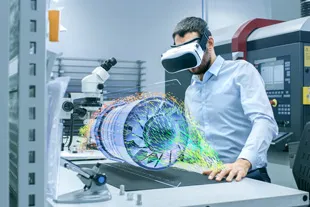1.Complex Assembly Optimization:
In automotive manufacturing, assembly processes often involve intricate procedures and meticulous attention to detail. AR and VR technologies streamline complex assembly tasks by providing engineers with real-time instructions and digital overlays. With AR glasses, engineers can visualize 3D models and receive step-by-step guidance, significantly enhancing efficiency and reducing errors in assembly operations.
2.Maintenance and Inspection:
AR VR solutions play a crucial role in maintenance activities within automotive manufacturing plants. These technologies enable engineers to conduct inspections and repairs with unprecedented efficiency. By overlaying digital information onto physical equipment, AR displays provide real-time insights into machine status and performance, facilitating timely maintenance interventions and minimizing downtime.
3.Remote Expert Support:
The integration of AR technology enables remote assistance and expert support for automotive technicians. Experts can visualize the technician’s field of view and provide real-time guidance through AR-enabled devices. This remote support capability reduces the need for onsite visits and enhances collaboration between teams, leading to faster problem resolution and improved operational efficiency.
4.Quality Assurance:
Enhancement AR systems are employed for quality assurance purposes in automotive manufacturing. By capturing images of vehicle components and comparing them with reference images using AR overlays, quality professionals can identify deviations from specifications and ensure product integrity. This meticulous quality control process enhances customer satisfaction and strengthens brand reputation.
5.Automation and Optimization:
The advent of Industry 4.0 has accelerated the automation of manufacturing processes in the automotive industry. AR and VR technologies facilitate seamless automation by providing real-time data insights and optimizing operational workflows. Automated fault detection applications powered by AR streamline maintenance operations, ensuring uninterrupted production and minimizing downtime.
6.Predictive Maintenance Strategies:
AR technology enables predictive maintenance strategies in automotive manufacturing plants. By recording and analyzing machine operating data, engineers can proactively identify maintenance needs and schedule timely interventions. This proactive approach to maintenance enhances equipment reliability, prolongs asset lifespan, and optimizes production efficiency.
7.Training and Skill Development:
AR and VR are invaluable tools for training automotive engineers and technicians. Virtual simulations and augmented reality-based training modules offer immersive learning experiences, allowing trainees to practice in realistic environments. By simulating complex scenarios and providing hands-on training, AR and VR enhance skill development and proficiency in automotive manufacturing processes.
8.Virtual Factory Floor Planning:
AR technology facilitates virtual factory floor planning and layout optimization in automotive manufacturing. Companies utilize AR-supported planning systems to superimpose virtual objects onto physical production environments, enabling visualization and validation of layout designs. This advanced planning capability enhances operational efficiency and facilitates seamless production workflows.
